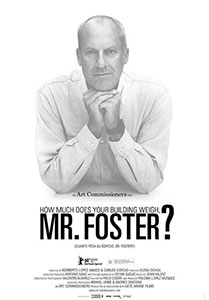Norberto López Amado and Carlos Carcas' documentary How Much Does Your Building Weigh, Mr. Foster?, currently playing in New York City, is a starry-eyed, unabashed love letter to one of the world's leading starchitects. It's also soulless hagiography.

With cold efficiency, the directors spend nearly 80 minutes sketching Lord Norman Foster's life: his Manchester childhood, self-made-architect origins, and a few hardships (the death of his first wife, his firm's near collapse after the Hongkong and Shanghai Bank project). But Foster’s successes are the primary concern of the film, which was produced by Elena Ochoa, the architect’s wife, for the Art Commissioners (U.K.) in association with Aiete Ariane Films (Spain). We're zipped through nearly 30 Foster projects around the world and overwhelmed by the filmmakers' awe of the aesthetic and functional wonder of his work, which often makes the film feel like architecture porn. We move in, out, and around facades and interiors of many of his projects. We see them from above and below. We scale wires and beams in extreme close-up, then linger just a little too long on recessed design features. It would be lewd if it weren't so beautiful. Director of Photography Velentín Álvarez brilliantly captures these projects and how they work with and are independent of their environments, especially when exploring the Millau Viaduct, the Hearst Tower, and the Reichstag. Whatever emotion this film claims is wrenched from Álvarez's cinematography.
But if you scratch the film's surface, that's all you find — surface. There's virtually no objective criticism of Foster or his work in How Much Does Your Building Weigh, Mr. Foster? Instead, we get unchecked adulation in the form of Deyan Sudjic's narration (he's the director of London's Design Museum and the film's writer), colleagues like Carl Abbott and Alain de Botton, artists like Anish Kapoor and Richard Serra, and Bono (because why not?). There's never a hint that Foster's work is anything but genius. This reaches its nadir when the film turns to his Masdar City project in Abu Dhabi, a zero-waste, carbon-neutral template for future cities. We only hear Foster extolling the plan's virtues. A hint of skepticism cracks through the narration, but is quickly paved over with fawning. "Will Masdar City be the first carbon-neutral city in the world? We don't know yet. If it works, it's a huge achievement. If it fails, it's a heroic failure." This propagandistic attitude permeates the film, quashing all dissention and debate about this or any other Foster project or, indeed, Foster himself.
Still, as primers go, How Much Does Your Building Weigh, Mr. Foster? is effective. The architecturally savvy likely won't find many new insights. But, like a textbook, the film engages with Foster's life and work just enough to encourage the curious newcomer to seek out more about his life and projects — especially the criticism.



Post a comment to this article
Report Abusive Comment